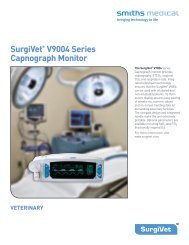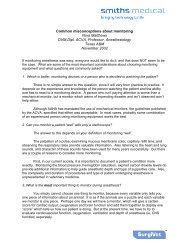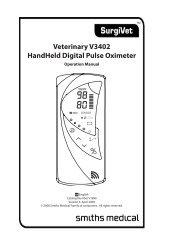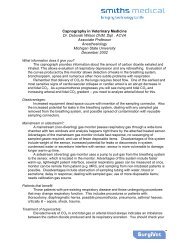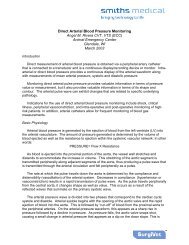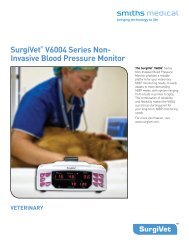Surgivet® V1030 Hand-Held Pulse Oximeter
Surgivet® V1030 Hand-Held Pulse Oximeter
Surgivet® V1030 Hand-Held Pulse Oximeter
You also want an ePaper? Increase the reach of your titles
YUMPU automatically turns print PDFs into web optimized ePapers that Google loves.
Chapter 4: Operating Instructions<br />
C Sensor<br />
• For cats and small breed dogs, place the sensor on the thigh, metatarsal or metacarpal, or<br />
hock near the saphenous vein.<br />
• For larger breed dogs, place the sensor over the Achilles tendon, tongue, prepuce or vulva,<br />
or through toe webbing.<br />
• It may be necessary to wet and part the fur with water in order to get the sensor closer to<br />
the skin of the patient.<br />
• For large animals (e.g. horses), place the sensor on the tongue.<br />
Reflectance Sensor<br />
• When using the reflectance sensor, wet and part the fur at the ventral tail base and use<br />
non-adhesive tape to hold the sensor in place. The reflectance sensor may be used rectally<br />
if the patient has a small or no tail.<br />
• It may be necessary to shave a small spot on the ventral tail base in patients with a thick<br />
undercoat, such as a Husky.<br />
Limitations<br />
Experience will quickly tell you which probes work best under different conditions. Fur, dark<br />
pigmentation, poor perfusion, and movement can all affect the sensor’s ability to obtain accurate<br />
readings. Well-perfused sites with little or no hair are preferable. It is also important to note that<br />
some anesthetic drugs, such as Xylazine (Rompun), Acepromazine, or Medetomidine (Domitor)<br />
can affect peripheral pulse pressures causing very weak pulsations. All pulse oximeters require<br />
a good quality pulse to work properly. Other drugs, such as ketamine, can cause the tongue to<br />
twitch, limiting the use of a lingual clip on that site.<br />
Cleaning or Disinfecting the Sensors<br />
Clean or disinfect reusable sensors before attaching to a new patient.<br />
WARNING! Unplug the sensor from the monitor before cleaning or disinfecting.<br />
WARNING! Do not autoclave, ethylene oxide sterilize, or immerse the sensors in liquid.<br />
Clean the sensor with a soft cloth moistened in water or a mild soap solution. To disinfect the<br />
sensor, wipe the sensor with a 70% isopropyl alcohol solution. If there is contamination with<br />
blood borne pathogens (BBPs) or other potentially infectious materials (OPIMs), then the use of a<br />
facility approved disinfectant of appropriate spectrum for the suspected organisms is appropriate.<br />
CAUTION! Do not immerse the sensor in any liquid.<br />
CAUTION! Cleaning with disinfectants, including alcohol, may shorten the life of the plastic<br />
or electronic parts, but appropriate disinfection must still be performed.<br />
Checking the Sensor and Oximetry Cable<br />
Follow these instructions each time before you attach the sensor to the patient. This helps ensure<br />
the sensor and oximetry cable are working properly.<br />
WARNING! Using a damaged oximetry sensor or cable may cause inaccurate readings.<br />
Inspect each sensor and cable. If a sensor or cable appears damaged, do<br />
not use it. Use another sensor or cable or contact your authorized service<br />
representative for help.<br />
4-10 Veterinary <strong>V1030</strong> <strong>Hand</strong>-<strong>Held</strong> <strong>Pulse</strong> <strong>Oximeter</strong> Operation Manual


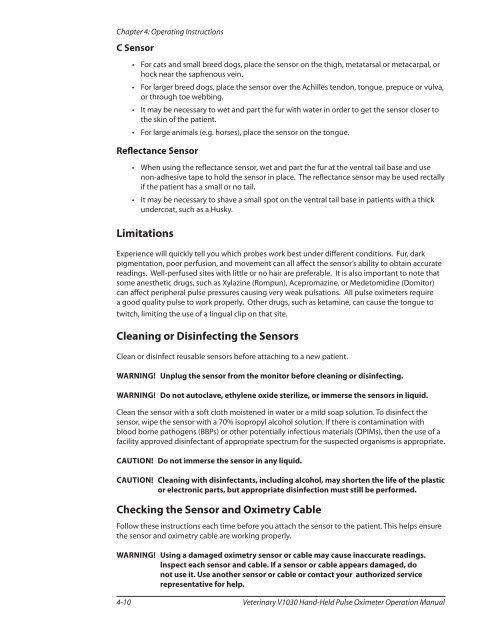
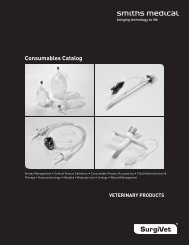
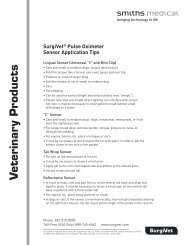
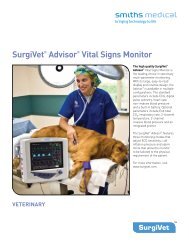
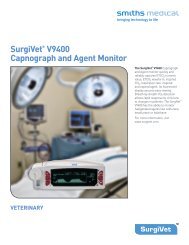
![Redemption Form [PDF] - SurgiVet](https://img.yumpu.com/37386077/1/190x245/redemption-form-pdf-surgivet.jpg?quality=85)
![Redemption Form [PDF] - SurgiVet](https://img.yumpu.com/37386066/1/190x245/redemption-form-pdf-surgivet.jpg?quality=85)
